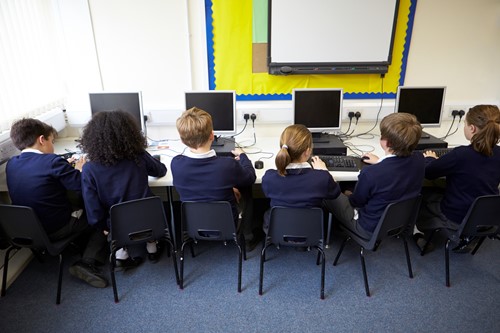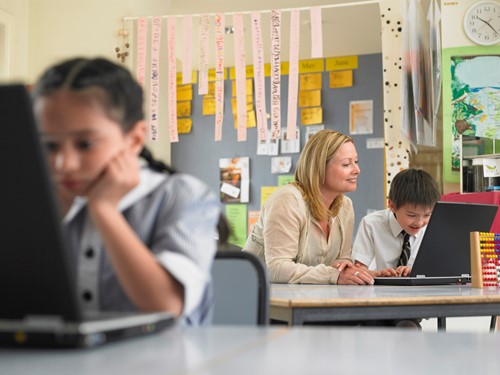
Membership-ready ICT activities to help you get started
If you’ve been hesitant to use digital tools in your classroom, you’re not alone. Many early childhood and primary teachers face the same challenge—how do you introduce technology meaningfully without disrupting what already works?
The key is starting with activities using technology in the classroom—ones that are simple to apply, curriculum-friendly, and come with professional learning support. That’s exactly what the ICT in Education Teacher Academy membership provides.
This blog introduces a series of ICT activities for kindergarten and ICT activities for primary school, each designed to help you move from hesitation to confidence.
Why Activities Work Best When You're Just Starting
Activities make ICT integration less intimidating because they:
-
Fit easily into your current routines.
-
Are ready to use with minimal setup.
-
Focus on learning outcomes, not the tech itself.
-
Allow you to experiment, reflect, and grow at your own pace.
But what makes these activities more than just “one-offs” is the membership structure behind them—helping you transform your practice through guided reflection, differentiation, and community support.
For Early Childhood Classrooms (Kindergarten)
These ICT activities build foundational digital skills through play, creativity, and exploration.
| ACTIVITY TITLE | IMPACT | OUTCOME | SUCCESS PATH STAGE |
|---|---|---|---|
| Learning About Computers | Introduces basic tech functions (keyboard, mouse) | Boosts fine motor skills & early digital literacy | Adoption → Adaptation |
| Outdoor Digital Storytelling | Encourages creativity through audio and visuals | Strengthens oral language and digital communication | Adaptation → Infusion |
| QR Code Nature Hunt | Combines inquiry with tech use outdoors | Fosters curiosity, teamwork & digital literacy | Adaptation → Infusion |
Features:
-
Tools: Tablets, drawing apps, QR scanners, microphones.
-
Differentiation: Activities scale from identifying computer parts to creating their own digital stories.
-
Curriculum: Aligned with EYLF outcomes like 4.4, 4.5, and 5.3.
For Primary School Classrooms
These classroom-ready activities go further with critical thinking, research, and problem-solving.
| ACTIVITY TITLE | IMPACT | OUTCOME | SUCCESS PATH STAGE |
|---|---|---|---|
| Digital Story Planning (Use graphic organisers to plan narratives in Word) |
Teaches sequencing and structure | Students learn to plan, draft, and revise using digital tools | Adoption → Adaptation |
| Multimodal Text Creation (Combine text, image, and audio using PowerPoint or Book Creator) |
Builds digital authorship skills | Develops ICT capability and creative expression | Adaptation → Infusion |
| Information Report Research (Use reliable search tools and note-taking apps) |
Enhances research and critical thinking | Strengthens digital literacy and comprehension | Adaptation → Infusion |
Features:
-
Digital tools used: Microsoft Word, Book Creator, Google Slides, reliable kid-safe browsers.
-
Differentiation: Activities range from typing and formatting text to embedding media and presenting.
-
Curriculum alignment: Matches ACARA’s General Capability—ICT, and supports English outcomes in literacy, writing, and digital communication.
How the Membership Helps You Implement and Grow
Each activity inside the ICT in Education Teacher Academy includes:
| MEMBERSHIP TOOL | WHAT IT HELPS YOU DO |
|---|---|
| Lesson Planning Template | Set clear learning intentions, select ICT tools, link outcomes |
| Observation Guide | Track student ICT use, engagement, and skill development |
| Reflection Prompts | Deepen your understanding and plan future improvements |
| Success Path Framework | Move through Adoption → Adaptation → Infusion → Transformation |
| Community Forum | Ask questions, receive ideas, and see how others apply the same activities |
Real Member Stories
Mia – Kindergarten Educator
Mia began with Learning About Computers and used the workbook’s planning page to connect EYLF outcomes to the activity. She:
-
Observed motor skill development using the Observation Guide.
-
Adapted the activity into a pretend play setup with cardboard computers.
-
Posted in the member community and received tips on how to extend the task further.
She’s now applying her learning to other tech activities and confidently supports student use of ICT across different areas.
Ben – Year 4 Teacher
Ben introduced Digital Story Planning to support his students’ narrative writing. He:
-
Used the template to structure a Word document with headings and graphic organisers.
-
Reflected using the membership workbook to assess which students were ready for independent multimodal tasks.
-
Built on this by moving into Multimodal Text Creation, helping students layer sound, images, and narration in Book Creator.
Now at the Infusion stage, Ben uses the workbook’s Success Path to plan progression and collects reflection notes as evidence for professional certification.
Activities That Fit Any Curriculum
Whether you're using EYLF, ACARA, UK EYFS, IB PYP or another curriculum, these membership activities:
-
Are outcome-based and flexible.
-
Allow for differentiation and inclusive access.
-
Build teacher confidence while supporting student engagement.
You’re not left figuring it out alone. Each activity is part of a structured path that supports your long-term development in ICT integration.
From Hesitation to Transformation
If you're unsure how to begin using technology in the classroom, start with an activity. But don’t stop there. Use the tools in the membership to plan it, observe it, reflect on it—and grow.
Every membership-ready ICT activity includes:
-
✔ Clear step-by-step teaching instructions
-
✔ Aligned learning outcomes and extension ideas
-
✔ ICT differentiation levels
-
✔ Professional reflection and observation templates
-
✔ Built-in growth tracking from Adoption to Transformation
Struggling to Use Technology in the Classroom? You’re Not Alone
Many educators want to integrate technology into their classrooms but often feel overwhelmed by the process. The challenge isn’t just about knowing which tools to use—it’s about understanding how to use ICT effectively to improve student learning.
That’s why evidence-based ICT teaching strategies are critical. They provide structured approaches to integrating technology in education, ensuring that it supports learning rather than becoming a distraction.
But where do you start?
The ICT in Education Teacher Academy is designed specifically for educators like you—offering professional development, teaching strategies, and step-by-step guidance on how to integrate ICT in the classroom effectively.
This blog will help you:
- Understand what makes an ICT teaching strategy effective
- Discover how to use technology in the classroom to engage students
- Learn how to integrate ICT in teaching using best practices
- Explore practical strategies for technology integration
- See how the ICT in Education Teacher Academy can support you in this journey
What Are the Biggest Barriers to Using ICT in Teaching?
Before you embrace classroom technology, it’s important to identify what’s stopping you.
Educators commonly face these challenges when trying to integrate ICT in education:
- Lack of ICT training – Many teachers have never been taught how to use ICT in classroom instruction.
- Fear of technical difficulties – What happens if the technology fails during a lesson?
- Time constraints – Planning effective ICT-based lessons can feel like an extra burden.
- Access to resources – Not all schools have the latest ICT tools for teaching and learning.
- Concerns about student engagement – How do you ensure students stay on task rather than getting distracted?
How the Membership Helps:
At the ICT in Education Teacher Academy, our technology in the classroom professional development provides you with:
- Workshops on best practices for integrating technology in the classroom
- Examples of ICT in the classroom to help you get started
- ICT strategy for schools to guide implementation at different learning levels
- Ongoing support from a community of educators facing the same challenges
What Are the Most Effective Teaching Strategies for Integrating ICT?
When implementing technology in education, the key is to use teaching strategies that support active learning.
Best Practices for Integrating Technology in the Classroom
Here’s how you can effectively incorporate ICT into your teaching:
- Start small – Use familiar ICT tools for teaching and learning, such as word processors or simple educational apps.
- Use technology to enhance learning, not replace it – Focus on tools that encourage critical thinking and creativity.
- Apply evidence-based instructional strategies using technology – This includes using digital collaboration tools, gamification, and interactive media.
- Encourage student autonomy – Let students explore different technology in the classroom examples, such as video creation or coding activities.
- Monitor and adjust your approach – Use formative assessments to see how ICT integration is affecting student learning.
How the Membership Helps:
The ICT in Education Teacher Academy provides:
- Structured professional development on ICT-based pedagogy
- Guides on instructional strategies using technology
- A digital resource library with ICT teaching methods
- Technology integration strategy plans to help with implementation
How Can You Make Technology Work for Your Classroom?
One of the biggest misconceptions about using ICT in education is that you need expensive or complex technology to make an impact.
The truth is, successful ICT use in the classroom comes from how you use technology, not just what you use.
Strategies for Using ICT in the Classroom Effectively
Here’s how to make the most of the technology available:
- Use ICT to support active learning – Students should be creating and interacting, not just consuming information.
- Incorporate a mix of ICT teaching methods – Balance hands-on activities with digital tools for teaching and learning.
- Develop ICT skills for students – Focus on teaching strategies using ICT that build digital literacy.
- Utilize technology to personalize learning – Adaptive learning platforms can help differentiate instruction.
- Encourage collaboration through ICT – Tools like shared documents, discussion forums, and ICT-based pedagogy support teamwork.
How the Membership Helps:
With the ICT in Education Teacher Academy, you get:
- Customizable ICT lesson plans for immediate classroom use
- Hands-on ICT teaching strategies that you can apply right away
- A digital learning community to share ideas and troubleshoot challenges
How Can ICT Teaching Strategies Enhance Student Learning?
(Applying ICT Strategies for Meaningful Classroom Impact)
Integrating technology in the classroom is not just about using digital tools—it’s about using them purposefully to enhance student learning. But how can educators ensure that ICT truly benefits students rather than just adding another layer of complexity? The answer lies in applying evidence-based ICT teaching strategies.

What Makes ICT an Effective Learning Tool?
ICT tools such as interactive whiteboards, word processors, digital presentations, and coding programs offer powerful opportunities to engage students. However, the key to successful ICT integration is to ensure that these tools:
- Support the learning objectives rather than becoming a distraction.
- Encourage active learning and critical thinking rather than passive consumption.
- Help students develop ICT capability—not just ICT skills, but the ability to apply digital tools effectively.
- Promote collaboration and creativity while improving communication and problem-solving skills.
Examples of ICT Teaching Strategies in Action
To see the real impact of ICT teaching strategies, let’s explore some practical examples of how they can be applied in different subject areas:
- Literacy: Using word processors for collaborative storytelling, enabling students to edit and refine their work with digital tools.
- Mathematics: Applying spreadsheets for data analysis, teaching students how to organize, interpret, and visualize numbers effectively.
- Science: Encouraging inquiry-based learning by using simulation software to conduct virtual experiments.
- Creative Arts: Developing digital literacy by allowing students to create animations, podcasts, or multimedia projects.
These strategies ensure that students are not just using technology, but thinking critically about how and why they use it—a skill essential for lifelong learning.
How Does the Membership Help You Implement These Strategies?
At the ICT in Education Teacher Academy, educators don’t just learn about these strategies—they apply them in their own classrooms with expert guidance and ongoing support. The membership is designed to bridge the gap between theory and practice, ensuring that educators:
- Gain access to structured ICT lesson plans that demonstrate best practices in integrating technology.
- Follow a clear learning pathway to build confidence in ICT integration.
- Engage in interactive workshops that focus on practical, hands-on application of ICT strategies.
- Receive expert guidance on choosing the right ICT tools for different subjects and learning needs.
Through the membership, you’ll not only learn evidence-based ICT teaching strategies but also develop a plan to implement them effectively in your classroom—ensuring that technology becomes a tool for deep learning rather than just a novelty.

What Are the Best ICT Tools for Teaching and Learning?
(Choosing the Right Technology to Enhance Student Learning)
Integrating ICT in education is about more than just having the latest tools—it’s about knowing how to use them effectively to support student learning. With so many digital tools available, how do educators choose the right ones?
The Role of ICT Tools in the Classroom
ICT tools can transform teaching and learning by:
- Encouraging active participation through hands-on digital experiences.
- Facilitating differentiated instruction by catering to diverse learning needs.
- Developing ICT capability by allowing students to use technology for problem-solving, research, and creativity.
- Enhancing engagement and motivation by making learning more interactive and relevant.
Examples of ICT Tools for Teaching and Learning
Educators in the ICT in Education Teacher Academy learn how to select and apply the most effective ICT tools in different subjects. Here are some essential tools that can be used across multiple learning areas:
1. Word Processors (e.g., Microsoft Word, Google Docs)
- Help students develop writing, editing, and formatting skills.
- Encourage collaborative learning through shared documents.
- Support literacy development by allowing students to draft and refine their work digitally.
2. Spreadsheets & Databases (e.g., Microsoft Excel, Google Sheets)
- Teach students data collection and analysis skills.
- Enable problem-solving and critical thinking in mathematics and science.
- Allow for real-world applications such as budgeting and scientific data recording.
3. Presentation Software (e.g., Microsoft PowerPoint, Prezi, Canva)
- Develop students’ ability to organize and communicate ideas visually.
- Promote public speaking skills through interactive presentations.
- Encourage creativity through the use of multimedia elements (videos, images, animations).
4. Digital Storytelling Tools (e.g., Adobe Spark, Book Creator)
- Enhance literacy by allowing students to create multimedia stories.
- Support cross-curricular learning by integrating text, images, and audio.
- Provide a platform for students to express their ideas creatively.
5. Coding & Computational Thinking (e.g., Scratch, Bee-Bots, Micro:bit)
- Build problem-solving skills by introducing basic programming concepts.
- Foster logical thinking and algorithmic reasoning in students.
- Support STEM education through hands-on learning.
6. Interactive Whiteboards & Tablets (e.g., Smartboards, iPads, Android Tablets)
- Encourage collaborative and interactive learning.
- Provide access to a variety of educational apps and resources.
- Enhance lesson delivery with real-time annotations and multimedia integration.
How Does the Membership Help Educators Make the Right ICT Choices?
In the ICT in Education Teacher Academy, members don’t just learn about ICT tools—they gain expert guidance on when, why, and how to use them effectively. The membership provides:
- Curated ICT resources for teaching and learning—saving educators time in researching and testing tools.
- Workshops that explore real-world classroom applications of digital tools.
- Step-by-step implementation strategies to ensure smooth technology integration.
- Opportunities for reflection and peer discussions on best practices.
By becoming a member, educators gain access to practical, classroom-tested ICT strategies that ensure technology enhances learning rather than becoming a distraction.

How Can Educators Implement Evidence-Based ICT Teaching Strategies?
(Applying ICT Effectively to Enhance Teaching and Learning)
Using technology in the classroom isn’t just about having the right tools—it’s about using them with effective, research-backed ICT teaching strategies that drive meaningful learning experiences.
What Are ICT Teaching Strategies?
ICT teaching strategies are intentional approaches to integrating technology into learning environments to improve student engagement, understanding, and ICT capability. These strategies help educators:
- Facilitate deep learning experiences rather than surface-level engagement.
- Ensure students use technology purposefully rather than as a passive tool.
- Develop students’ problem-solving and critical thinking skills using ICT.
- Encourage collaboration, creativity, and independent learning.
Evidence-Based ICT Teaching Strategies That Work
Educators in the ICT in Education Teacher Academy gain access to proven teaching methods for integrating ICT in meaningful ways. Here are some strategies that ensure technology enhances, rather than replaces, the learning experience.
1. Plan for Learning Progression in ICT Capability
- ICT capability isn’t built in a single lesson—it develops over time.
- Teachers should assess students’ current ICT skills and plan progressive activities that challenge their abilities.
- Example: Instead of only teaching students how to type in Word, progress to formatting, inserting images, and creating hyperlinks to deepen their learning.
2. Model ICT Use Through Direct Instruction
- Teachers should demonstrate effective technology use rather than assuming students already know how to use digital tools.
- Use explicit teaching techniques, such as guided demonstrations, to help students navigate ICT tools efficiently.
- Example: Instead of simply assigning a PowerPoint project, model effective slide design, image placement, and animation use.
3. Foster Higher-Order Thinking with ICT
- ICT should be used for analysis, evaluation, and creation, not just for basic tasks.
- Encourage students to problem-solve and explore different solutions using technology.
- Example: Instead of only teaching students how to input numbers in a spreadsheet, have them analyze trends in data and make predictions.
4. Scaffold ICT Activities for Independent Learning
- Use gradual release strategies to shift responsibility from the teacher to the student.
- Provide step-by-step guidance initially, then allow students to apply ICT skills independently.
- Example: Guide students through basic video editing in the first lesson, then assign a project where they create their own multimedia presentations.
5. Integrate ICT in Authentic and Real-World Contexts
- Digital learning is most effective when it mirrors real-world applications.
- Incorporate ICT in projects that relate to students’ lives and interests.
- Example: Have students collaborate on a blog, create digital portfolios, or record a podcast on a topic they’re passionate about.
6. Promote Collaboration and Digital Literacy
- Encourage peer learning and digital communication through collaborative platforms.
- Teach responsible technology use and online safety alongside ICT skills.
- Example: Use Google Docs for real-time collaboration, allowing students to work on projects together and provide feedback to one another.
How Does the Membership Help Educators Apply These Strategies?
The ICT in Education Teacher Academy is designed to support educators at every stage of technology integration. Through the membership, educators receive:
- Step-by-step lesson plans that apply evidence-based ICT teaching strategies.
- Workshops and courses that focus on practical implementation in real classrooms.
- Reflective activities in the membership workbook, ensuring teachers can apply, assess, and refine their strategies over time.
- A supportive community of educators sharing insights and best practices.
The Academy’s structured approach ensures that technology integration is not overwhelming or ineffective—but rather, a well-planned, evidence-based process that improves student learning outcomes.

How Can Educators Assess and Track Student Learning in ICT?
(Measuring the Impact of ICT Teaching Strategies in the Classroom)
Effective ICT integration isn’t just about using technology—it’s about understanding how well students are developing their ICT capability and applying digital tools meaningfully. Educators must assess student learning with technology to ensure that ICT is not only engaging but also enhancing their knowledge, skills, and problem-solving abilities.
Why Is Assessing ICT Learning Important?
Assessment helps educators:
- Measure student progress in ICT capability.
- Identify gaps in digital skills and problem-solving abilities.
- Ensure that technology is used effectively for learning rather than passively.
- Adjust teaching strategies to better support student development.
Key Strategies for Assessing ICT in the Classroom
Members of the ICT in Education Teacher Academy gain access to structured assessment tools, reflective checklists, and tracking methods to evaluate student progress effectively. Here’s how educators can assess and track ICT learning in real-time.
1. Use Formative Assessment to Guide Learning
- Observations: Watch how students interact with technology—are they making decisions independently or struggling with basic skills?
- Questioning Techniques: Ask students to explain their thought process when using ICT tools.
- Digital Learning Logs: Encourage students to document their progress in an online journal or class blog.
✔ Example: During a digital storytelling lesson, ask students to explain why they chose certain multimedia elements and how they help convey their story.
2. Assess ICT Capability, Not Just Skills
ICT capability is more than knowing how to use technology—it’s about making informed decisions on when and why to use it. Educators should assess:
- Routine ICT techniques (e.g., saving files, formatting text).
- Higher-order thinking skills (e.g., problem-solving with technology, evaluating sources).
- Conceptual understanding (e.g., understanding the role of digital tools in different subjects).
✔ Example: Instead of grading students on their ability to create a PowerPoint, assess how effectively they structure information and present ideas using ICT.
3. Use Performance-Based Assessments
- Design tasks that require students to apply ICT in real-world scenarios.
- Encourage students to create, analyze, and present information using digital tools.
- Assess the process, not just the final product—did students make independent ICT choices?
✔ Example: Have students conduct a digital research project, evaluate their sources, and present their findings in an interactive infographic or video.
4. Provide Self-Assessment and Peer Feedback Opportunities
Students develop a deeper understanding of ICT when they reflect on their learning and receive feedback from their peers.
- Self-assessment checklists: Ask students to rate their confidence in using ICT tools.
- Peer reviews: Encourage collaboration and feedback using shared digital platforms (e.g., Google Docs).
- Reflection prompts: Have students document challenges they faced and how they overcame them.
✔ Example: After a coding activity, ask students to reflect on their learning journey—what challenges did they encounter, and how did they solve them?
5. Track Student Progress Over Time
- Use digital portfolios to collect student work samples.
- Implement rubrics for ICT capability assessment aligned with curriculum standards.
- Compare student progress over multiple projects to identify trends in digital skill development.
✔ Example: In the ICT in Education Teacher Academy, educators use structured progress-tracking templates to monitor how students improve in using digital tools for learning.
How Does the Membership Support Educators in ICT Assessment?
The ICT in Education Teacher Academy provides structured assessment tools, workshops, and templates to help educators:
- Track student progress in ICT capability over time.
- Access rubrics for evaluating digital learning outcomes.
- Use formative and summative assessment techniques to measure the impact of ICT teaching strategies.
- Gain expert guidance on aligning ICT assessments with curriculum standards.
With the Academy’s workbook activities and reflection exercises, educators don’t just assess student learning—they assess their own teaching strategies to ensure they are continuously improving in their approach to technology integration.

Why Is Ongoing Professional Development Essential for ICT Teaching Strategies?
(Ensuring Long-Term Success in Technology Integration in the Classroom)
Technology in education is constantly evolving, and successful ICT integration is an ongoing process that requires continuous learning, reflection, and adaptation. Educators need ongoing professional development to stay up to date with best practices, new digital tools, and evidence-based ICT teaching strategies.
At the ICT in Education Teacher Academy, professional learning isn’t just about attending a single workshop—it’s about building long-term expertise and confidence in technology integration.
The Importance of Continual Professional Development in ICT Teaching Strategies
1. Teaching with Technology Requires More Than Just ICT Skills
Educators need pedagogical strategies to effectively integrate technology into learning. Simply knowing how to use a tool isn’t enough—teachers must:
- Understand when and why to use digital tools to enhance subject learning.
- Develop a student-centered approach that encourages problem-solving, creativity, and independent thinking.
- Implement best practices for integrating ICT across different key learning areas.
✔ Example: The ICT in Education Teacher Academy offers workshops on pedagogical strategies for teaching with ICT, ensuring that educators move beyond basic technology skills to meaningful classroom applications.
2. ICT Strategies Must Be Adaptable to Different Learning Environments
Each classroom is unique, and effective ICT teaching strategies must be tailored to:
- Varying student ICT capabilities—some students may be digital natives, while others need more foundational support.
- Different learning needs—including differentiation for diverse learners.
- The available technology—ensuring teachers make the most of what they have in their schools.
✔ Example: The Academy’s Professional Learning Community allows members to share challenges and solutions, gaining insights from fellow educators on how to adapt strategies for different classroom settings.
3. Digital Technologies in Education Require Ongoing Reflection and Improvement
Technology integration isn’t a one-time achievement—it’s a continuous cycle of learning, applying, and refining strategies. Educators must:
- Reflect on what’s working and what needs improvement in their ICT integration.
- Use student feedback and assessment data to adjust their teaching strategies.
- Stay updated on new educational technologies and research-based ICT practices.
✔ Example: The membership workbook includes structured reflection exercises that help teachers assess the impact of their ICT teaching strategies and make informed improvements.
How the ICT in Education Teacher Academy Supports Continual Professional Development
The ICT in Education Teacher Academy is designed to provide educators with:
- Technology in the Classroom Professional Development—expert-led workshops that provide evidence-based ICT teaching strategies.
- Step-by-Step Learning Pathways—including the Technology Integrator’s Learning Journey to Transformation, guiding educators through each stage of technology integration.
- Hands-On Learning & Application—members apply what they learn through lesson planning activities, interactive workshops, and classroom implementation.
- A Reflective Learning Model—educators don’t just learn strategies; they track their progress and refine their approach with guided self-assessment tools.
- Ongoing Support from a Professional Learning Community—collaborate with other teachers, gain new ideas, share experiences, and receive expert guidance.
Why is this important? Unlike traditional one-off professional development, the membership provides continuous learning and mentorship, ensuring that teachers don’t just learn ICT teaching strategies—they master them and apply them effectively in their classrooms.

Bringing It All Together: Becoming a Member of the ICT in Education Teacher Academy
Educators who want to truly transform their approach to technology integration need ongoing learning, support, and practical application.
By becoming a member of the ICT in Education Teacher Academy, teachers gain access to:
- Proven ICT teaching strategies that make a real impact in student learning.
- Continuous professional development opportunities that ensure long-term success in technology integration.
- An active community of educators who share insights, experiences, and innovative practices.
- A structured success path that helps teachers move from beginner-level technology integration to expert-level confidence in ICT pedagogy.
🚀 Join the ICT in Education Teacher Academy today and take your ICT teaching strategies to the next level
Download and Grow with our activities using technology in the classroom today - Save $40 instantly when paying annually!

